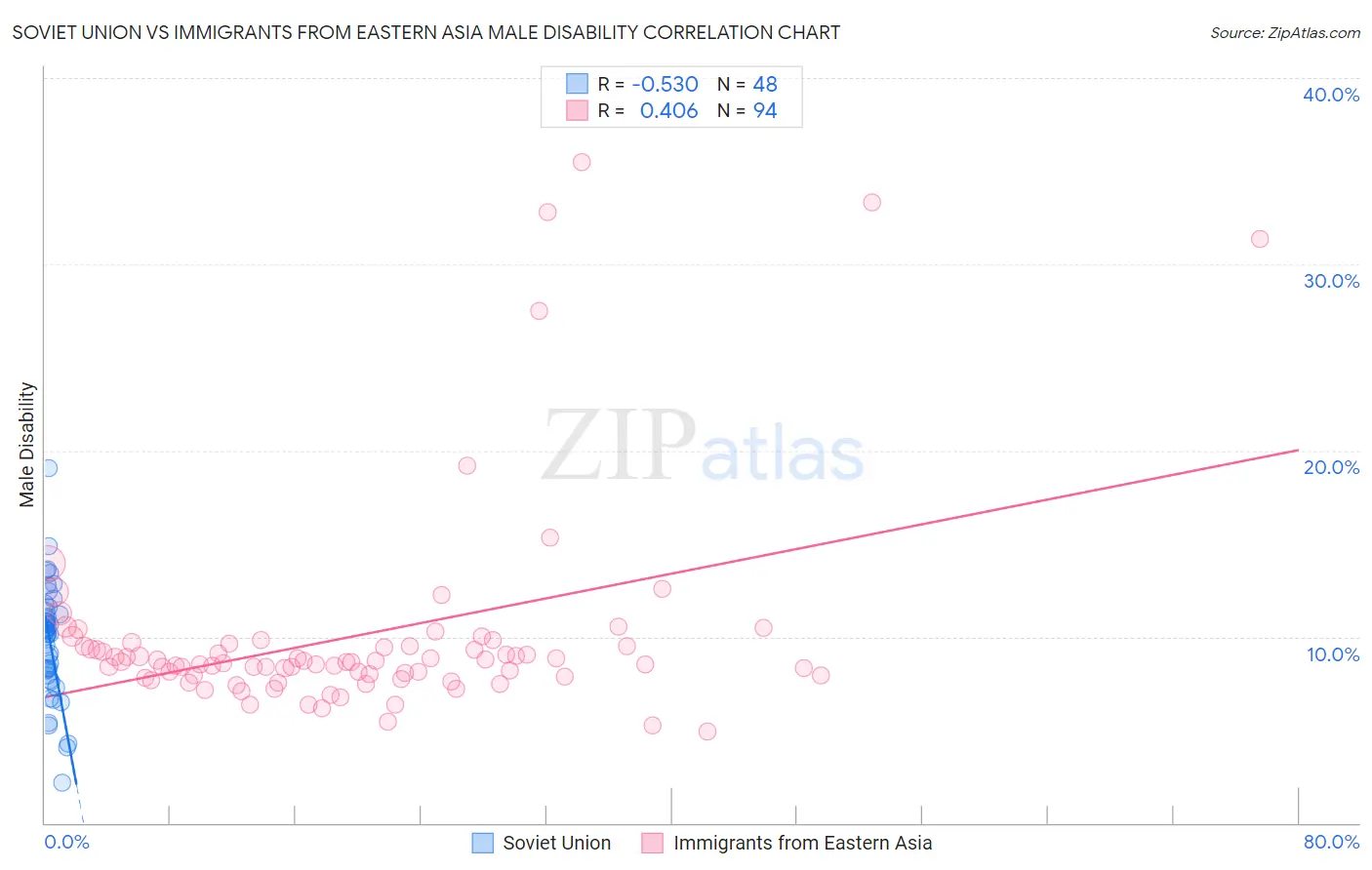Soviet Union vs Immigrants from Eastern Asia Male Disability
COMPARE
Soviet Union
Immigrants from Eastern Asia
Male Disability
Male Disability Comparison
Soviet Union
Immigrants from Eastern Asia
10.1%
MALE DISABILITY
99.9/ 100
METRIC RATING
31st/ 347
METRIC RANK
9.6%
MALE DISABILITY
100.0/ 100
METRIC RATING
11th/ 347
METRIC RANK
Soviet Union vs Immigrants from Eastern Asia Male Disability Correlation Chart
The statistical analysis conducted on geographies consisting of 43,487,843 people shows a substantial negative correlation between the proportion of Soviet Union and percentage of males with a disability in the United States with a correlation coefficient (R) of -0.530 and weighted average of 10.1%. Similarly, the statistical analysis conducted on geographies consisting of 499,820,999 people shows a moderate positive correlation between the proportion of Immigrants from Eastern Asia and percentage of males with a disability in the United States with a correlation coefficient (R) of 0.406 and weighted average of 9.6%, a difference of 5.2%.

Male Disability Correlation Summary
| Measurement | Soviet Union | Immigrants from Eastern Asia |
| Minimum | 2.2% | 4.9% |
| Maximum | 19.1% | 35.5% |
| Range | 16.9% | 30.6% |
| Mean | 9.8% | 10.0% |
| Median | 10.2% | 8.7% |
| Interquartile 25% (IQ1) | 8.0% | 7.9% |
| Interquartile 75% (IQ3) | 11.2% | 9.5% |
| Interquartile Range (IQR) | 3.2% | 1.6% |
| Standard Deviation (Sample) | 3.0% | 5.6% |
| Standard Deviation (Population) | 3.0% | 5.6% |
Demographics Similar to Soviet Union and Immigrants from Eastern Asia by Male Disability
In terms of male disability, the demographic groups most similar to Soviet Union are Immigrants from Egypt (10.1%, a difference of 0.070%), Venezuelan (10.1%, a difference of 0.10%), Vietnamese (10.1%, a difference of 0.26%), Egyptian (10.1%, a difference of 0.28%), and Paraguayan (10.1%, a difference of 0.60%). Similarly, the demographic groups most similar to Immigrants from Eastern Asia are Bolivian (9.6%, a difference of 0.24%), Iranian (9.7%, a difference of 0.46%), Immigrants from Iran (9.7%, a difference of 0.56%), Indian (Asian) (9.7%, a difference of 1.0%), and Okinawan (9.8%, a difference of 1.6%).
| Demographics | Rating | Rank | Male Disability |
| Immigrants | Eastern Asia | 100.0 /100 | #11 | Exceptional 9.6% |
| Bolivians | 100.0 /100 | #12 | Exceptional 9.6% |
| Iranians | 100.0 /100 | #13 | Exceptional 9.7% |
| Immigrants | Iran | 100.0 /100 | #14 | Exceptional 9.7% |
| Indians (Asian) | 100.0 /100 | #15 | Exceptional 9.7% |
| Okinawans | 100.0 /100 | #16 | Exceptional 9.8% |
| Immigrants | Korea | 100.0 /100 | #17 | Exceptional 9.8% |
| Immigrants | Pakistan | 100.0 /100 | #18 | Exceptional 9.8% |
| Immigrants | Sri Lanka | 100.0 /100 | #19 | Exceptional 10.0% |
| Asians | 100.0 /100 | #20 | Exceptional 10.0% |
| Burmese | 100.0 /100 | #21 | Exceptional 10.0% |
| Immigrants | Venezuela | 100.0 /100 | #22 | Exceptional 10.0% |
| Cypriots | 100.0 /100 | #23 | Exceptional 10.0% |
| Immigrants | Asia | 100.0 /100 | #24 | Exceptional 10.0% |
| Immigrants | Malaysia | 99.9 /100 | #25 | Exceptional 10.0% |
| Paraguayans | 99.9 /100 | #26 | Exceptional 10.1% |
| Egyptians | 99.9 /100 | #27 | Exceptional 10.1% |
| Vietnamese | 99.9 /100 | #28 | Exceptional 10.1% |
| Venezuelans | 99.9 /100 | #29 | Exceptional 10.1% |
| Immigrants | Egypt | 99.9 /100 | #30 | Exceptional 10.1% |
| Soviet Union | 99.9 /100 | #31 | Exceptional 10.1% |